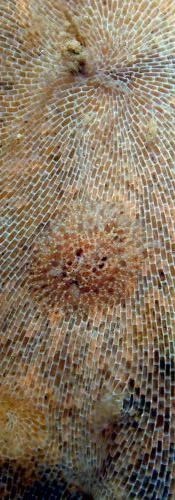
Corambe pacifica
MacFarland & O'Donoghue, 1929
Order: NUDIBRANCHIA
Suborder: DORIDINA
Family: Corambidae
DISTRIBUTION
West coast, N. America
PHOTO
Corambe pacifica on bryozoan colony [Membranipora membranacea] found attached to kelp [Macrocystis pyrifera). Santa Barbara Channel, California. Bryozoan colony approx 25mm long. Corambe approx 4mm long/ Photos: Genevieve Anderson.
The animals is remarkably well camouflaged when on the bryozoan colony on which it feeds. It is an oval, flattened, disk-like shape, slightly arched in the central region of the body. There is a wide mantle skirt which has a deep, circular notch in the posterior midline. The head is small with short, blunt oral tentacles. The rhinophores are translucent clear, and can retract into a sheath. The anus opens in the posterior midline. The gills are a series of simple, pinnate plumes, ranging in number in mature individuals from 6 to 14 on each side. They sit beneath the mantle in the posterior midline. The mantle is translucent clear with a slight pinkish tinge. The colour pattern consists of regularly arranged orange-brown patches separated by a pattern of opaque white spots and more diffuse white dusting, to mimic the colour pattern of the bryozan colony. Sometimes some of the orange-brown patches are much darker, or lighter than the rest. The foot is translucent clear with a narrow, white, marginal line. They grow to approximately 15 mm in length. They are usually found on kelp, usually Macrocystis, and seagrasses bearing incrustations of Membranipora upon which they feed exclusively. They are often found in competitive coexistence with Doridella steinbergae, and there have been a considerable number of papers written about their ecology. Species of Doridella have recently been placed in the genus Corambe. [see message].
References:
• Behrens, D.W. (1980). Pacific Coast Nudibranchs: A guide to the Opisthobranchs of the Northeastern Pacific. Sea challengers, Los Osos, California.
• MacFarland, F.M.& O'Donoghue, C.H. (1929). A new species of Corambe from the Pacific coast of North America. Proceedings of the California Academy of Sciences, fourth series, 18(1): 1-27.
• Yoshioka, P.M. (1986). Life history patterns of the dorid nudibranchs Doridella steinbergae and Corambe pacifica. Marine Ecology Progress Series, 31: 179-184.
• Yoshioka, P.M. (1986). Competitive coexistence of the dorid nudibranchs Doridella steinbergae and Corambe pacifica. Marine Ecology Progress Series, 33: 81-88.
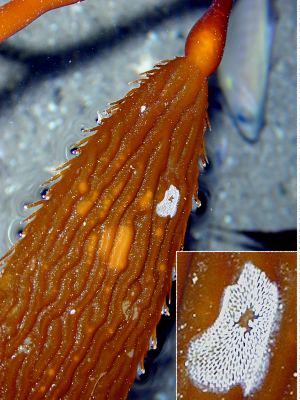
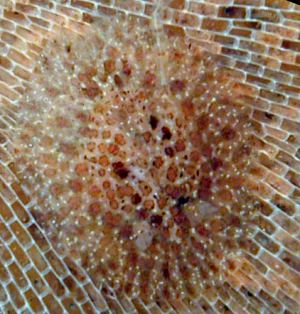
Rudman, W.B., 2003 (February 27) Corambe pacifica MacFarland & O'Donoghue, 1929. [In] Sea Slug Forum. Australian Museum, Sydney. Available from http://www.seaslugforum.net/find/corapaci
Related messages
Re: Corambe pacifica swimming?
November 26, 2007
From: Judith Garfield
Concerning message #21088:
Hi Dave,
Thanks for your response. I don't think I was the culprit in that I was not swimming through kelp at the time. I can say that while the Corambe was below me, it was forward of me and so not near my fins. Either way, I am confident of its flexion behavior. It absolutely wasn't floating or drifting. It was under its own convulsive steam...as it were. Could it be that "swimming" might be worthwhile for an animal likely to settle so high up in the water column and on a substrate that dies and breaks off?
Locality: La Jolla Cove area, 2 feet deep, California, USA, Pacific Ocean, 12 July 2006, rocky reef to sand bottom. Length: 6-7 mm long.
Judith Garfield
jgarfield@ucsd.edu
Garfield, J., 2007 (Nov 26) Re: Corambe pacifica swimming?. [Message in] Sea Slug Forum. Australian Museum, Sydney. Available from http://www.seaslugforum.net/find/21125Dear Judith,
Dave's away at the moment so I'll share a few thoughts of my own. It certainly wouldn't do Corambe any harm to be able to swim a bit, but I would suspect that occasions that would cause the kelp to break off would involve or create such strong water movements that the meagre flutterings of Corambe would be rather meaningless. The flutterings could be an escape response but like so many behaviours we see in nature, we really have no idea if they are of value.
Best wishes,
Bill Rudman
Corambe pacifica from Carmel, California
November 10, 2007
From: Clinton Bauder
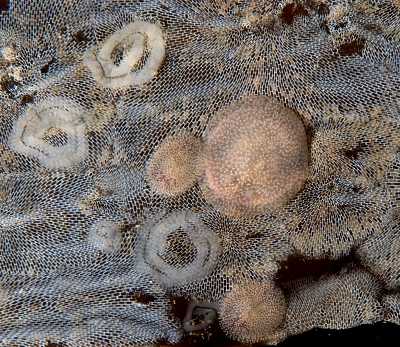
Hi Bill,
Here is another cryptic kelp-dweller for you. I'm pretty certain these animals are Corambe pacifica. I found the egg ribbons first and the fact that they are quite different (being spirals rather than half-moons) from C. steinbergae is what alerted me to these slugs being a different species. As with C. steinbergae it took a bit to find them even after I'd found the eggs as they are nearly invisible on their byrozoan prey. Looking at the pictures you can see the posterior notch and the gill plume which I think make them C. pacifica though in my examples these features are more subtle than the picture in the Behrens and Hermosillo book.
Locality: Point Lobos, 15 meters, California, USA, Pacific, 13 October 2007, Macrocystis Kelp Blade. Length: 5-10 mm. Photographer: Clinton Bauder.
Clinton Bauder
gecko1@apple.com
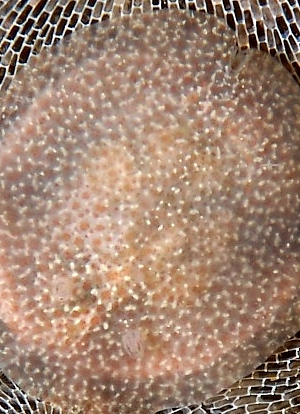
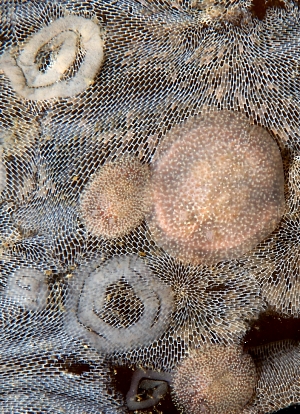
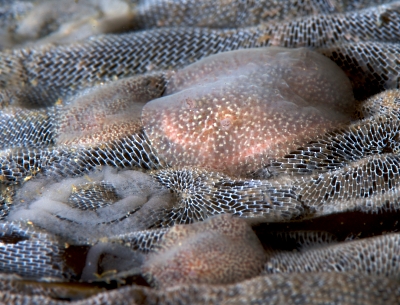
Hi Clinton,
Good show. Yes, they are almost invisible, from above. I love your oblique photo (right), as it shows the height of the specimens. This is exactly how I tell Branchers to look for these guys.
Thanks for sharing,
Dave Behrens
Corambe pacifica swimming?
November 10, 2007
From: Judith Garfield
Has anyone seen Corambe pacifica swimming? I was snorkel-swimming off La Jolla Shores, San Diego, California, when I noticed a lot of activity a foot below the water's surface. I realized that it was a Corambe. I grabbed a piece of bryozoan-encrusted Macrocystis nearby and placed it under the animal. It alighted and "dissappeared" against its backdrop. Since many species of nudibranchs don't swim, I am interested to find out if anyone else has seen this.
Locality: La Jolla, 2 feet below surface, CA, USA, Pacific Ocean, 12 July 2006, water column. Length: 6-7 mm long. Photographer: no picture.
Judith Garfield
jgarfield@ucsd.edu
Garfield, J., 2007 (Nov 10) Corambe pacifica swimming?. [Message in] Sea Slug Forum. Australian Museum, Sydney. Available from http://www.seaslugforum.net/find/21088Hi Judith,
Interesting observation. Since very few people ever find this highly cryptic animal in the first place, I am sure you are likely the first to see one "swimming." This is the first report of this behavior I have ever heard of. I am wondering if you might have dislodged the critter while snorkeling. Cryptic dorids like this species don't really have a need to swim with their food so abundant, and their disguise so perfect.
Thanks for sharing this observation,
Dave Behrens
Corambe pacifica from southern California
March 6, 2003
From: Bill Rudman

Here are some photos of Corambe pacifica that Genny Anderson has sent me. She studied this animal and Doridella steinbergae for her MA. See her wonderful website at http://www.biosbcc.net/ocean/flindex.htm which she describes as 'a virtual trip to the Santa Barbara tidepools'.
Photos: Corambe pacifica on bryozoan colony [Membranipora membranacea] found attached to kelp [Macrocystis pyrifera). Santa Barbara Channel, California. Bryozoan colony approx 25mm long. Corambe approx 4mm long/ Photos: Genevieve Anderson. .
Genevieve Anderson
anderson@sbcc.edu
Biological Sciences Department,
Santa Barbara City College
Best wishes,
Bill Rudman


